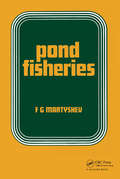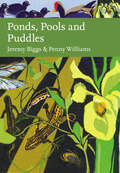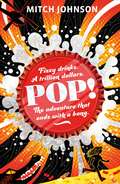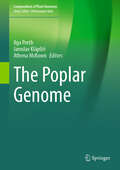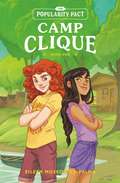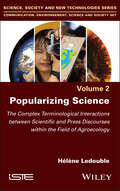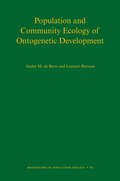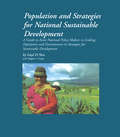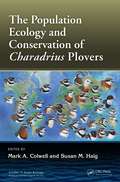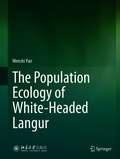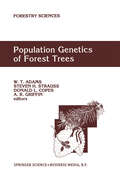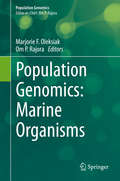- Table View
- List View
Polychlorinated Dibenzo-p-dioxins and -furans (Environmental Toxin Series #3)
by S. Safe, O. Hutzinger and T. A. HillPond: Pond (Nature Trail #4)
by Jen GreenThe purpose of this series is to show children the habitats around them. The books will guide a child through their personal exploration of different habitats. The reader will be encouraged to use key science skills to plan, observe, collect, record and and preserve their findings on their trail of nature.
Pond Conservation in Europe (Developments in Hydrobiology #210)
by Beat Oertli Régis Céréghino Jeremy Biggs Steven Declerck Andrew P. Hull Maria Rosa MiraclePonds are an exceptional freshwater resource around the world and represent thirty percent of the global surface area of standing water. Furthermore, the millions of ponds which exist exhibit a particularly high biodiversity and have a high potential for ecosystem functions and services. Despite these impressive features, ponds face many threats from a variety of human activities and receive little or no protection under European and national legislation. Consequently, there is an urgent need to protect, consolidate and increase the pond resource in Europe. In order to achieve these objectives, the European Pond Conservation Network (EPCN) was launched 2004 in Geneva. Its aim is to promote the awareness, understanding and conservation of these small water bodies in the European landscape. This volume of “Developments in Hydrobiology” presents a selection of 31 papers presented during EPCN conferences held in 2006 in France (Toulouse) and in 2008 in Spain (Valencia). They represent a diverse collection of themes from across the continent and North Africa and present new and original insights into topics as wide ranging as pond biodiversity; human disturbance; landscape ecology; ecological assessment and monitoring; practical management measures; ecological restoration; hydrology and climate change; invasive species and threatened species.
Pond Fisheries
by F. MartyshevA comprehensive study of pond fisheries. Topics include the organisation and construction of fish ponds, production processes in fish farms for warmwater carp and cold-water trout, and irrigation networks and reservoirs constructed for multipurpose exploitation.
Pond Fisheries
by F. MartyshevA comprehensive study of pond fisheries. Topics include the organisation and construction of fish ponds, production processes in fish farms for warmwater carp and cold-water trout, and irrigation networks and reservoirs constructed for multipurpose exploitation.
Ponds, Pools and Puddles (Collins New Naturalist Library)
by Jeremy Biggs Penny WilliamsPonds and pools are a common feature of our landscape – there are at least ten times as many ponds as lakes in the UK – and they are also important wildlife habitats. This book provides a comprehensive and detailed account of these freshwater habitats.
Pool Care For Dummies
by Kristine BlanchardCrystal-clear advice for maintaining a crystal-clear swimming pool Keeping a swimming pool ready for use requires some chemistry know-how, an understanding of how pool mechanics work, and some time spent doing good old-fashioned cleaning work. Pool Care For Dummies offers a reliable, comprehensive resource for building the knowledge that lets you turn pool maintenance into a do-it-yourself task. Written by a certified swimming pool professional who started taking care of pools when she was 5 years old, this book helps you separate the good advice from the bad as you learn to build an upkeep schedule, figure out what chemicals you actually need and which are less-than-magical potions, and fix the common problems that plague all pool owners. With so much trustworthy pool care advice in one place, you can finally cut back on time spent searching for swimming pool advice and more time splashing with your friends and family! Learn how pools work and get the tools you need to keep your pool running Test your water and maintain a safe swimming environment Care for your and balance your above-ground or in-ground pool Know what to do when unexpected problems arisePrivate pool owners who need to know what’s what in the water will love this clear and complete Dummies guide.
Pool Care For Dummies
by Kristine BlanchardCrystal-clear advice for maintaining a crystal-clear swimming pool Keeping a swimming pool ready for use requires some chemistry know-how, an understanding of how pool mechanics work, and some time spent doing good old-fashioned cleaning work. Pool Care For Dummies offers a reliable, comprehensive resource for building the knowledge that lets you turn pool maintenance into a do-it-yourself task. Written by a certified swimming pool professional who started taking care of pools when she was 5 years old, this book helps you separate the good advice from the bad as you learn to build an upkeep schedule, figure out what chemicals you actually need and which are less-than-magical potions, and fix the common problems that plague all pool owners. With so much trustworthy pool care advice in one place, you can finally cut back on time spent searching for swimming pool advice and more time splashing with your friends and family! Learn how pools work and get the tools you need to keep your pool running Test your water and maintain a safe swimming environment Care for your and balance your above-ground or in-ground pool Know what to do when unexpected problems arisePrivate pool owners who need to know what’s what in the water will love this clear and complete Dummies guide.
Pop!: Fizzy drinks. A trillion dollars. The adventure that ends with a bang.
by Mitch JohnsonAn outrageous theft. A huge reward. Two friends on the run. An uproariously funny, action-packed new adventure about the power of courage, standing up for what's right, and fizzy drinks, from the award-winning author of Kick.Queenie de la Cruz stares out at the ocean and dreams of a world beyond her small-town. She's about to get her wish... When the priceless recipe to the world's most popular drink - thought to be lost forever - washes up at her feet, Queenie's life instantly changes. Everyone wants it, and with a $10 million bounty on her head, Queenie's soon on the run. Pursued by bounty hunters, black-ops helicopters and angry mobs, Queenie's journey involves a mad scientist, a tin foil hat-wearing conspiracy theorist, a crocodile and an unlikely new friend, Todd. But being on the run also makes Queenie begin to see the world around her more clearly - a world in which a big corporation's excess has left the planet covered in its plastic bottles and waste. Suddenly, the home she always dreamed of escaping, and the ocean she grew up with and took for granted, don't seem so bad.If Queenie and Todd can bring down the bad guys, maybe she can go back home and make a difference...
The Poplar Genome (Compendium of Plant Genomes)
by Ilga Porth Jaroslav Klápště Athena McKownThis book is the first comprehensive compilation of research on state‐of‐the-art genomics on the most advanced model tree species including genome assemblies, insights into genomic structural features and methylation patterns, whole‐genome resources used for population genomics and adaptation to climate, enabled breeding vs. classical genetics and traditional breeding, comparative genomics, and elucidations on functional genomics. The latest developments in the genomics of wood formation are particularly highlighted. Altogether, the book contains over 300 pages in over 15 chapters authored by globally reputed experts in the relevant fields of this tree crop’s genomics research. This book is useful for students, teachers, and scientists in academia and governmental or private tree improvement agencies or companies interested in genetics, pathology, entomology, physiology, molecular genetics and breeding, in vitro culture and genetic engineering, land restoration, and agroforestry solutions.
Popular Representations of Development: Insights from Novels, Films, Television and Social Media (Rethinking Development)
by David Lewis Dennis Rodgers Michael WoolcockAlthough the academic study of development is well established, as is also its policy implementation, less considered are the broader, more popular understandings of development that often shape agendas and priorities, particularly in representative democracies. Through its accessible and provocative chapters, Popular Representations of Development introduces the idea that while the issue of ‘development’ – defined broadly as problems of poverty and social deprivation, and the various agencies and processes seeking to address these – is normally one that is discussed by social scientists and policy makers, it also has a wider ‘popular’ dimension. Development is something that can be understood through studying literature, films, and other non-conventional forms of representation. It is also a public issue, one that has historically been associated with musical movements such as Live Aid and increasingly features in newer media such as blogs and social networking. The book connects the effort to build a more holistic understanding of development issues with an exploration of the diverse public sphere in which popular engagement with development takes place. This book gives students of development studies, media studies and geography as well as students in the humanities engaging with global development issues a variety of perspectives from different disciplines to open up this new field for discussion.
Popular Representations of Development: Insights from Novels, Films, Television and Social Media (Rethinking Development)
by David Lewis Dennis Rodgers Michael WoolcockAlthough the academic study of development is well established, as is also its policy implementation, less considered are the broader, more popular understandings of development that often shape agendas and priorities, particularly in representative democracies. Through its accessible and provocative chapters, Popular Representations of Development introduces the idea that while the issue of ‘development’ – defined broadly as problems of poverty and social deprivation, and the various agencies and processes seeking to address these – is normally one that is discussed by social scientists and policy makers, it also has a wider ‘popular’ dimension. Development is something that can be understood through studying literature, films, and other non-conventional forms of representation. It is also a public issue, one that has historically been associated with musical movements such as Live Aid and increasingly features in newer media such as blogs and social networking. The book connects the effort to build a more holistic understanding of development issues with an exploration of the diverse public sphere in which popular engagement with development takes place. This book gives students of development studies, media studies and geography as well as students in the humanities engaging with global development issues a variety of perspectives from different disciplines to open up this new field for discussion.
The Popularity Pact: Book One (The Popularity Pact #1)
by Eileen Moskowitz-PalmaIn the blink of a summer, Bea goes from having a best friend and a place she belongs to being dropped and invisible, eating lunch alone and only talking to teachers. The end of sixth grade and the start of Camp Amelia can't come soon enough. But then the worst part of school, ex-best friend Maisy, shows up in Bea's safe place and ruins it all. Maisy lands in the same bunk as Bea and summer suddenly seems dire. Never having camped a day in her life, Maisy agrees: it's hopeless. She should be at home, spending time with her little sister and hanging out with her super popular crew of friends--not at this stupid adventure camp failing everything and being hated by everyone. In a desperate bid to belong, Maisy offers Bea a deal: if Bea helps her fit in at the camp, she will get Bea into the M & M's, their town's popular clique, when they enter seventh grade in the fall. The Popularity Pact is born.
The Popularity Pact: Book One (The Popularity Pact #1)
by Eileen Moskowitz-PalmaIn the blink of a summer, Bea goes from having a best friend and a place she belongs to being dropped and invisible, eating lunch alone and only talking to teachers. The end of sixth grade and the start of Camp Amelia can't come soon enough. But then the worst part of school, ex-best friend Maisy, shows up in Bea's safe place and ruins it all. Maisy lands in the same bunk as Bea and summer suddenly seems dire. Never having camped a day in her life, Maisy agrees: it's hopeless. She should be at home, spending time with her little sister and hanging out with her super popular crew of friends--not at this stupid adventure camp failing everything and being hated by everyone. In a desperate bid to belong, Maisy offers Bea a deal: if Bea helps her fit in at the camp, she will get Bea into the M & M's, their town's popular clique, when they enter seventh grade in the fall. The Popularity Pact is born.
Popularizing Science: The Complex Terminological Interactions between Scientific and Press Discourses within the Field of Agroecology
by Hélène LedoubleMedia coverage of scientific issues is a highly complex process. It involves making a specialized field accessible to the general public, without necessarily disseminating the associated scientific terms or knowledge. The terminological interactions between press discourses and scientific knowledge are presented within the field of agroecology. The analysis of textual data focuses on articles in the general press in French and English, devoted to plant protection practices using natural mechanisms (biological control). This book provides a terminological and cognitive overview of the issues involved in popularizing science in a rapidly expanding field, and of the challenges to be met in the constantly evolving environmental communication sector.
Popularizing Science: The Complex Terminological Interactions between Scientific and Press Discourses within the Field of Agroecology
by Hélène LedoubleMedia coverage of scientific issues is a highly complex process. It involves making a specialized field accessible to the general public, without necessarily disseminating the associated scientific terms or knowledge. The terminological interactions between press discourses and scientific knowledge are presented within the field of agroecology. The analysis of textual data focuses on articles in the general press in French and English, devoted to plant protection practices using natural mechanisms (biological control). This book provides a terminological and cognitive overview of the issues involved in popularizing science in a rapidly expanding field, and of the challenges to be met in the constantly evolving environmental communication sector.
Population and Community Ecology of Ontogenetic Development
by André M. de Roos Lennart PerssonMost organisms show substantial changes in size or morphology after they become independent of their parents and have to find their own food. Furthermore, the rate at which these changes occur generally depends on the amount of food they ingest. In this book, André de Roos and Lennart Persson advance a synthetic and individual-based theory of the effects of this plastic ontogenetic development on the dynamics of populations and communities. De Roos and Persson show how the effects of ontogenetic development on ecological dynamics critically depend on the efficiency with which differently sized individuals convert food into new biomass. Differences in this efficiency--or ontogenetic asymmetry--lead to bottlenecks in and thus population regulation by either maturation or reproduction. De Roos and Persson investigate the community consequences of these bottlenecks for trophic configurations that vary in the number and type of interacting species and in the degree of ontogenetic niche shifts exhibited by their individuals. They also demonstrate how insights into the effects of maturation and reproduction limitation on community equilibrium carry over to the dynamics of size-structured populations and give rise to different types of cohort-driven cycles. Featuring numerous examples and tests of modeling predictions, this book provides a pioneering and extensive theoretical and empirical treatment of the ecology of ontogenetic growth and development in organisms, emphasizing the importance of an individual-based perspective for understanding population and community dynamics.
Population and Strategies for National Sustainable Development: A guide to assist national policy makers in linking population and environment in strategies for development
by Gayl D Ness Meghan V GolayThe guide serves as a resource for national-level policy makers and the staff of conservation organizations who wish to integrate population and environmental conditions in planning for sustainable development. It presents the basic rationale for linking population and environmental issues, including the demonstrable impact that growth in population and consumption is having on the environment. At the same time, it acknowledges the difficulty of achieving integration due to long-entrenched disciplinary and institutional specialization. The guide refrains from making blanket prescriptions, but rather emphasizes that policy and planning responses must be attuned to the location-specific nature of population-environment interactions. A number of mechanisms for achieving integration are presented, including placement of demographers within national planning organizations, or creation of country-based networks of population and conservation professionals who meet regularly to share knowledge and experience. For those less familiar with previous research, the book includes a primer on demographic change and models and frameworks for understanding the links between population dynamics (births, deaths, growth, migration) and environmental change.Originally published in 1996
Population and Strategies for National Sustainable Development: A guide to assist national policy makers in linking population and environment in strategies for development (Health And Population Set Ser.)
by Gayl D Ness Meghan V GolayThe guide serves as a resource for national-level policy makers and the staff of conservation organizations who wish to integrate population and environmental conditions in planning for sustainable development. It presents the basic rationale for linking population and environmental issues, including the demonstrable impact that growth in population and consumption is having on the environment. At the same time, it acknowledges the difficulty of achieving integration due to long-entrenched disciplinary and institutional specialization. The guide refrains from making blanket prescriptions, but rather emphasizes that policy and planning responses must be attuned to the location-specific nature of population-environment interactions. A number of mechanisms for achieving integration are presented, including placement of demographers within national planning organizations, or creation of country-based networks of population and conservation professionals who meet regularly to share knowledge and experience. For those less familiar with previous research, the book includes a primer on demographic change and models and frameworks for understanding the links between population dynamics (births, deaths, growth, migration) and environmental change.Originally published in 1996
Population Biology: Concepts and Models
by Alan HastingsPopulation biology has been investigated quantitatively for many decades, resulting in a rich body of scientific literature. Ecologists often avoid this literature, put off by its apparently formidable mathematics. This textbook provides an introduction to the biology and ecology of populations by emphasizing the roles of simple mathematical models in explaining the growth and behavior of populations. The author only assumes acquaintance with elementary calculus, and provides tutorial explanations where needed to develop mathematical concepts. Examples, problems, extensive marginal notes and numerous graphs enhance the book's value to students in classes ranging from population biology and population ecology to mathematical biology and mathematical ecology. The book will also be useful as a supplement to introductory courses in ecology.
The Population Ecology and Conservation of Charadrius Plovers (Studies in Avian Biology #53)
by Mark A. Colwell Susan M. HaigThe 40 or so species of beach-loving plovers (genus Charadrius) comprise a diverse group of shorebirds found around the world. Most of these species are challenged by changing climates and other human-related development activities, yet they provide key insights into basic ecological and evolutionary processes. The expert international contributors take a comparative approach, presenting examples from many worldwide plover studies and synthesizing the group’s most pressing and important topics. The book further presents an emphasis on full life-cycle biology, including the importance of examining migratory connectivity issues, even for non-migratory plovers. Key Features Serves as a fundamental resource for conservation practitioners Detailed overview of a widely distributed group of shorebirds Authored by renowned specialists who present theoretical and applied perspectives Emphasis on comparative and synthetic approach in all chapters Related Titles McComb, B. et al. Monitoring Animal Populations and Their Habitats: A Practitioner’s Guide (ISBN 978-0-4291-3827-0). Garvey, J. E. & M. R. Whiles. Trophic Ecology (ISBN 978-1-4987-5846-8). Dewdney, A. K. Stochastic Communities: A Mathematical Theory of Biodiversity (ISBN 978-1-1381-9702-2).
The Population Ecology of White-Headed Langur
by Wenshi PanThis book offers a rare and detailed insight into 20 years’ of in-depth field research and conservation of the white-headed langur. It focuses on the white-headed langur’s natural refuge, territory and home range, diets and foraging strategies, behavior modes, reproductive strategies, population, possible future viabilities, and their interaction with human society. From 1996 through 2016, a small research team led by Prof.Wenshi Pan from Peking University conducted studies and conservation efforts on the white-headed langur, one of the most endangered endemic species of China, in Guangxi and saved the species from extinction. With the help of conservationists’ efforts, the white-headed langur population in Nongguan Mountains, Guangxi, gradually increased from 105 to approximately 820.This book shares the success story of the unification of human development and wildlife conservation.
Population Genetics of Forest Trees: Proceedings of the International Symposium on Population Genetics of Forest Trees Corvallis, Oregon, U.S.A., July 31-August 2,1990 (Forestry Sciences #42)
by W. T. Adams Steven H. Strauss Donald L. Copes A. R. GriffinTropical climates, which occur between 23°30'N and S latitude (Jacob 1988), encompass a wide variety of plant communities (Hartshorn 1983, 1988), many of which are diverse in their woody floras. Within this geographic region, temperature and the amount and seasonality of rainfall define habitat types (UNESCO 1978). The F AO has estimated that there 1 are about 19 million km of potentially forested area in the global tropics, of which 58% were estimated to still be in closed forest in the mid-1970s (Sommers 1976; UNESCO 1978). Of this potentially forested region, 42% is categorized as dry forest lifezone, 33% is tropical moist forest, and 25% is wet or rain forest (Lugo 1988). The species diversity of these tropical habitats is very high. Raven (1976, in Mooney 1988) estimated that 65% of the 250,000 or more plant species of the earth are found in tropical regions. Of this floristic assemblage, a large fraction are woody species. In the well-collected tropical moist forest of Barro Colorado Island, Panama, 39. 7% (481 of 1212 species) of the native phanerogams are woody, arborescent species (Croat 1978). Another 21. 9% are woody vines and lianas. Southeast Asian Dipterocarp forests may contain 120-200 species of trees per hectare (Whitmore 1984), and recent surveys in upper Amazonia re corded from 89 to 283 woody species ~ 10 cm dbh per hectare (Gentry 1988). Tropical communities thus represent a global woody flora of significant scope.
Population Genomics: Marine Organisms (Population Genomics)
by Marjorie F. Oleksiak Om P. RajoraPopulation genomics has provided unprecedented opportunities to unravel the mysteries of marine organisms in the oceans' depths. The world's oceans, which make up 70% of our planet, encompass diverse habitats and host numerous unexplored populations and species. Population genomics studies of marine organisms are rapidly emerging and have the potential to transform our understanding of marine populations, species, and ecosystems, providing insights into how these organisms are evolving and how they respond to different stimuli and environments. This knowledge is critical for understanding the fundamental aspects of marine life, how marine organisms will respond to environmental changes, and how we can better protect and preserve marine biodiversity and resources. This book brings together leading experts in the field to address critical aspects of fundamental and applied research in marine species and share their research and insights crucial for understanding marine ecosystem diversity and function. It also discusses the challenges, opportunities and future perspectives of marine population genomics.
Population Viability in Plants: Conservation, Management, and Modeling of Rare Plants (Ecological Studies #165)
by Christy A. Brigham Mark W. SchwartzProviding a quantitative assessment of threatened plant populations, that holds for varying management scenarios, has become an essential part of conservation planning. Here, renowned plant ecologists provide information on: major threats to plants, when and where to conduct a plant viability assessment (PVA), what type of PVA to conduct, what alternative options to PVA are available, what information is required for which kind of viability assessment, what attributes of the population in question should be considered, and what the limits of the PVA would be. As such, this volume can be used as a training tool for the environmental manager or a teaching aid for reviewing the current state of knowledge on plant population viability.



